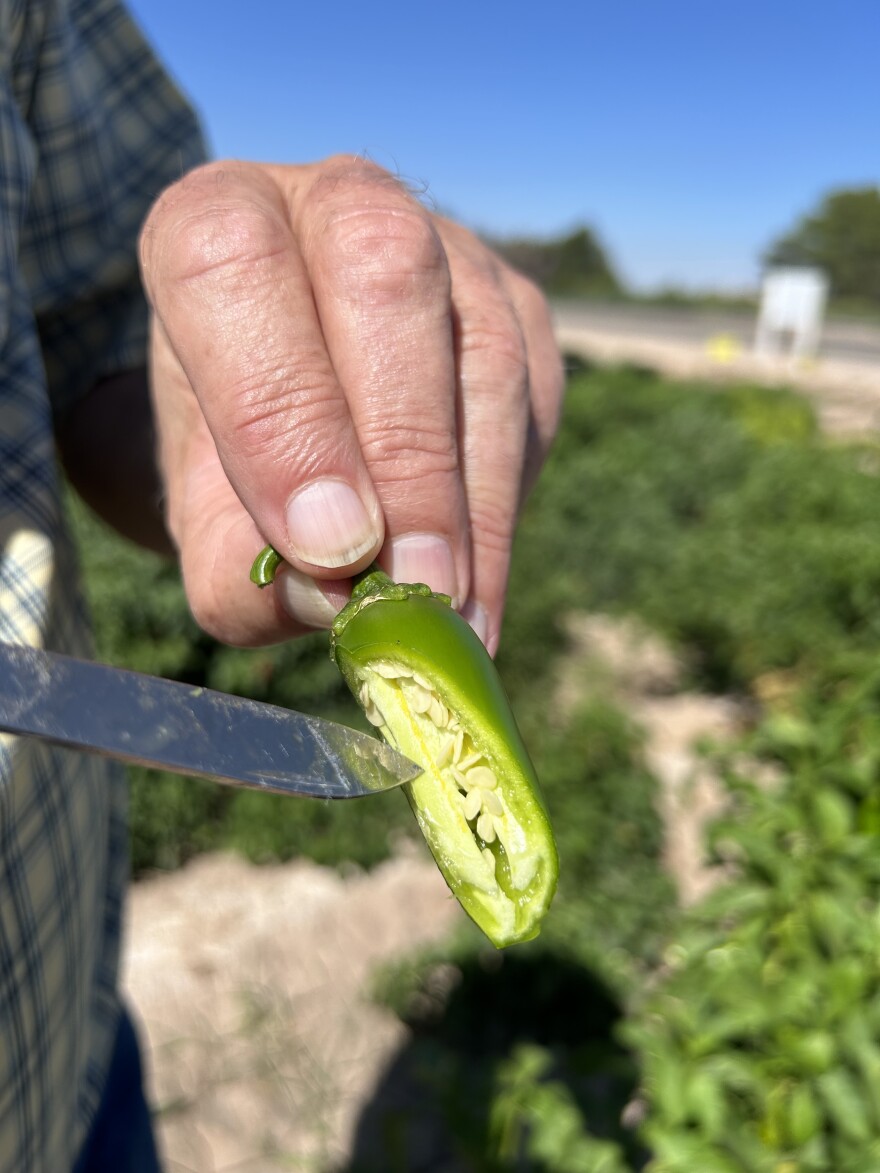On a sunny morning in the Chile Pepper Institute Teaching Garden at NMSU filled with a light fragrant smell of chile, Dr. Paul Bosland, NMSU’s Professor of Horticulture Emeritus and Director Emeritus of the Chile Pepper Institute, is giving me a tour of the chile garden. He shares what started him on the road to chile.

“I was hired at the university in 1986 to be a vegetable breeder. And so when I first came to NMSU, I worked on broccoli and cabbage; I worked on a little bit of spinach, asparagus, and chiles. But it didn’t take very long before I knew chiles would be my major emphasis in my research career, and I always like to say I put all my chiles into one basket, and watch that basket carefully.”
According to Dr. Bosland the right conditions are needed to grow good chile.
“Oh, Mother Nature has to be kind to you. This has not been a good year and 2022 with the heat. Chiles don’t really like it that hot. If it goes over 95 degrees Fahrenheit, they won’t set fruit. But they’re native to the tropical rain forest, so they like it about 68, 72 degrees Fahrenheit every day, with a gentle rain about every three days. So what we’ve done here is adapted this plant to New Mexico. We selected it to grown in this heat, to take some of the set fruit in a little higher temperature.”
The garden tour proper begins with the chile I most want to see.
“The very first chile we have here is the Chiltepin, the wild chile. And that’s what I call “the mother of all chiles.” All chiles are native to the Western hemisphere, so when humans migrated to the Western hemisphere, they came in contact. And it’s always kind of a surprise: you’d think the first person that took a bite of the chile, they got pain, it hurt, the heat hit ‘em. But they went back for it. And I believe that was because it was a medicinal plant. And then humans started to select the different shapes, colors, flavors, and what I call the “heat profile”—the way the heat reacts when you eat ‘em.”

Dr. Bosland then listed the heat profile’s five characteristics.
“First, how fast does the heat come on? Is it rapid, or delayed? (The second is) How long does it linger? Does the heat stay for minutes or hours? Third, is where do you sense the heat? Tip of your tongue, your lips, mid-palate, or the back of your throat? And the fourth one is an interesting one, in which I call sharp or flat? Sharp is like a prickly heat; we say it’s like pins kind of sticking you. Where the flat heat has been paintbrushed in there. New Mexican types have that flat type; where Asian types, like where you’d get at an Asian restaurant, those little Asian-type chiles, have that sharp heat; you have that prickly heat. And then the fifth characteristic is the heat level: mild, medium, or hot.”
He then took a green pepper and sliced it open to show me how to tell how hot a chile is.

“There’s no way to tell from the outside. But what you have to do is cut ‘em open. And inside where the seeds attach, there’s a vein, a yellow vein. That’s where the heat of a chile is. The walls of a chile don’t have any heat. Only that yellow vein. People say seeds are hot, but they’re not. So before you buy a sack of chile, you can always ask someone to cut one open, and look at it and go “Okay, I’ve got a sense of how hot It’s gonna be.” The bigger the yellow vein, the hotter it will be.”
Dr. Bosland talked about Fabian Garcia, the first horticulturalist at New Mexico State University, who was hired to find new crops for growers.
“He looked at apples, peaches; he introduced pecans; he looked at onions, he introduced sweet onions. And then he looked at chiles. And the only chiles being grown were in back yards, what we would call a kitchen garden. And he said, “I wonder if I made a more uniform, milder chile, could I get non-Hispanics to eat ‘em?”
Garcia then began a hybridization program using three different chiles.
“The Pasilla; one called Chile Negro, which was a dark small one; and Chile Colorado, which is a small, red one, kind of similar to what we grow in Northern New Mexico, the Chimayo Velarde type. He hybridized that, and he selected a line that’s a little longer; and the typical chile that’s being roasted now, that green chile, was what he released, and he released a variety called #9. And he called it #9 because in the plots, it was the #9 plot that he liked the best. So he just called it New Mexico #9, released it, and it became a big hit.”
It would take another visit or two for me to fully appreciate the riches that are grown in the Chile Pepper Institute Teaching Garden, which is open to visitors seven days a week from 8 til 5.






